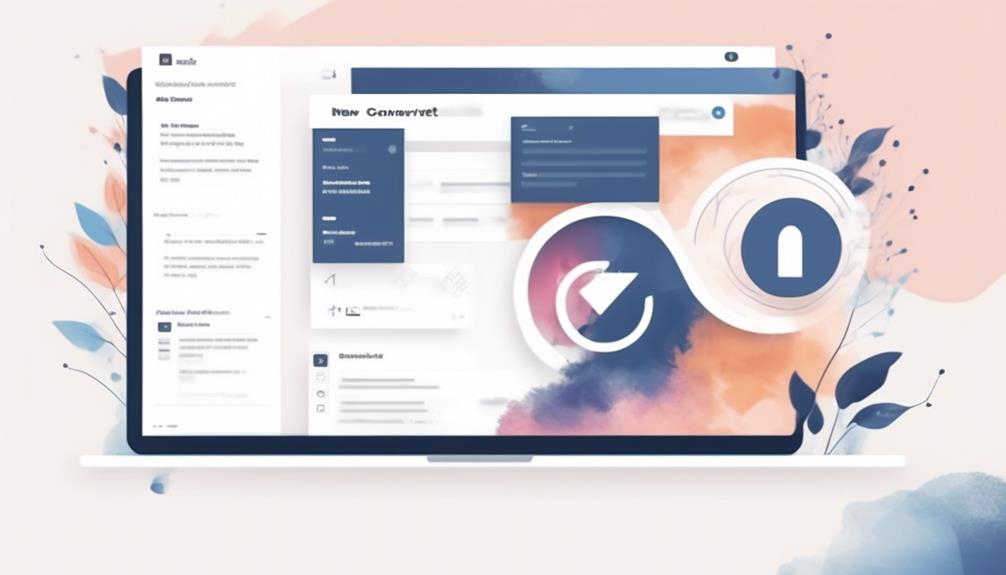We have all been through it – sending out emails with high hopes, only to have some bounce back to us. Did you know that the average bounce rate for email campaigns is around 1.75%? Although it may seem low, it can have a significant impact on your sender reputation and your ability to effectively deliver emails.
So, how do we tackle this issue and ensure our email lists are clean and effective?
Well, removing bounced emails from Mailchimp is a crucial step, and in this discussion, we’ll explore the best methods to do so.
Key Takeaways
- Use Mailchimp’s segmentation feature to identify contacts with bounced email addresses and categorize them as soft bounces (temporary) or hard bounces (permanent).
- Analyze bounce data and utilize Mailchimp’s bounce report to identify patterns or issues affecting email deliverability, such as high numbers of hard bounces or potential spam complaints.
- Promptly remove hard bounces using the ‘Remove’ button in Mailchimp’s bounce report to maintain a clean email list and improve campaign deliverability.
- Regularly monitor the bounce rate, review bounce reasons, and clean the email list to prevent bounced emails, maintain sender reputation, and adhere to email campaign best practices.
Identifying Bounced Emails
To identify bounced emails in Mailchimp, we can utilize the segmentation feature to isolate contacts with bounced email addresses. Bounced emails are categorized as soft bounces, which are temporary, and hard bounces, which are permanent.
Hard bounces occur when an email can’t be delivered due to invalid or non-existent email addresses. By creating a segment in Mailchimp and setting segment conditions to identify contacts with hard bounces, we can effectively find the information we need. It’s crucial to distinguish between hard and soft bounces to ensure that valid email addresses aren’t mistakenly removed from our list.
Utilizing Mailchimp’s segmentation feature allows us to pinpoint these bounced emails and take the necessary actions, such as removing them from our contact list. This process ensures that our email list remains clean and free from invalid addresses, reducing the likelihood of emails bouncing back or being marked as spam.
Understanding the difference between hard and soft bounces is essential in effectively managing email bounces and maintaining a healthy email list.
Practices for preventing bounced emails involve best practices such as using double opt-in, regularly cleaning your list, and monitoring deliverability rates.
Reviewing Bounce Reasons

When reviewing bounce reasons, we analyze the data to identify patterns or issues that may be affecting our email deliverability. It’s crucial to distinguish between hard bounces, which occur when an email is sent to an invalid or non-existent email address, and soft bounces, which typically result from temporary issues such as a full inbox or a temporarily unavailable email server. Mailchimp’s bounce report provides detailed information on the types of bounces, allowing us to pinpoint the specific causes behind each bounce.
By reviewing bounce reasons, we can identify trends such as a high number of hard bounces, which may indicate a need to clean our email list and remove invalid or inactive email addresses. Additionally, analyzing bounce reasons can help us uncover potential spam complaints, issues with spam filters, or problems with our email campaigns that could be leading to an increased bounce rate.
Understanding the reasons behind bounces enables us to take proactive measures to rectify issues and ensure that our email list consists of valid email addresses, ultimately improving our email deliverability and the effectiveness of our email marketing efforts.
Removing Bounced Emails
After identifying hard bounces using Mailchimp’s bounce report, our next step is to remove these invalid or non-existent email addresses from our email list to maintain deliverability and sender reputation.
To remove hard bounces in Mailchimp, we need to review the bounce reasons provided in the bounce report. Within the report, we can find an option to remove the hard bounces. Mailchimp simplifies this process by offering a ‘Remove’ button next to each hard bounce, allowing us to efficiently clean our email list.
By promptly removing hard bounces, we ensure that our email marketing efforts are targeted towards valid and active recipients, which in turn enhances our deliverability rate and the overall success of our email campaigns.
It’s crucial to regularly monitor our email list for bounced addresses and take appropriate action to keep it clean. Mailchimp plays a vital role in tracking email delivery and automatically removing bounced addresses from our audience, which significantly contributes to improving our deliverability and maintaining a positive sender reputation.
In case of any difficulties, we can always contact Mailchimp Support for assistance with removing bounced emails.
Monitoring Bounce Rate

How can we effectively monitor the bounce rate in Mailchimp?
Monitoring bounce rate is crucial for maintaining a healthy email list and ensuring successful email campaigns. Here are some key steps to effectively monitor the bounce rate in Mailchimp:
- Regularly check the bounce report: Mailchimp provides a bounce report that identifies hard bounces. Review this report frequently to stay updated on the bounce rate and identify any patterns or issues causing high numbers of hard bounces.
- Use the provided Remove button: When hard bounces happen, it’s important to remove them promptly. Mailchimp offers a convenient Remove button to help users easily remove hard bounces from their lists.
- Log in to your Mailchimp account: Users can log in to their Mailchimp accounts to access the bounce report, review bounce reasons, and take necessary actions to clean their email list.
It’s essential to monitor the bounce rate regularly because a high number of hard bounces can often be caused by a variety of reasons, such as invalid or inactive email addresses. By effectively removing hard bounces, you can maintain a clean email list and improve the deliverability of your campaigns.
Preventing Bounced Emails
To prevent bounced emails in Mailchimp, understanding the distinction between hard bounces, which are permanent, and soft bounces, which are temporary, is crucial for implementing effective preventive measures. Hard bounces occur when an email is rejected due to reasons like the recipient’s address being invalid or the email being marked as spam. On the other hand, soft bounces happen when the recipient’s mailbox is full or the mail server is temporarily down. By identifying and addressing the reasons for bounces, we can take proactive steps to prevent them and maintain a healthy email list.
| Preventive Measures | Description |
|---|---|
| Maintain Clean Email List | Regularly clean your email list by removing inactive or invalid addresses. |
| Ensure Opt-in Subscriber Addresses | Confirm that all subscribers have opted in to receive your emails to minimize the risk of bounce. |
| Adhere to Email Campaign Best Practices | Follow best practices such as avoiding spammy content and using clear subject lines to reduce the likelihood of emails being rejected. |
| Use Email Verification Service | Consider using services like EmailListValidation to scan and remove invalid email addresses from your Mailchimp audience. |
| Monitor Bounce Reports | Regularly review Mailchimp’s bounce reports to identify hard bounces and take necessary actions to prevent further delivery failures. |
Frequently Asked Questions
Does Mailchimp Clean Soft Bounces?
Yes, Mailchimp does clean soft bounces.
Soft bounces are temporary delivery issues, and Mailchimp automatically retries sending to these addresses.
If the soft bounces persist, Mailchimp will eventually treat them as hard bounces and remove them from your audience.
This automated process helps maintain a clean and engaged audience, ensuring that your emails reach valid recipients.
How Do I View Bounced Emails in Mailchimp?
We view bounced emails in Mailchimp by accessing the bounce report. This report provides insight into hard bounces, helping us identify and address invalid email addresses or other issues.
By utilizing the provided ‘Remove’ button, we can efficiently manage hard bounces. It’s crucial to regularly monitor these reports to maintain a clean email list and optimize deliverability rates.
Implementing best practices and using tools like EmailListValidation can further enhance our email marketing efforts.
How Do I Get Rid of Cleaned Emails in Mailchimp?
We remove cleaned emails in Mailchimp by accessing the Audience tab, selecting All contacts, and choosing the Cleanup inactive contacts option. This allows us to remove cleaned emails and maintain a clean and engaged contact list.
This helps improve deliverability and ensures our communications reach active subscribers. Regularly cleaning our contact list is essential for maintaining a healthy email marketing strategy and maximizing our campaign’s effectiveness.
How Do I Manage Bounced Emails?
We manage bounced emails in Mailchimp by regularly monitoring our email campaign reports and identifying the bounced emails.
Then, we remove the bounced emails from our lists to maintain a clean and accurate subscriber base.
This ensures that our future email campaigns reach active and engaged recipients, improving our deliverability and overall email marketing performance.
Regular list maintenance is essential for a successful email marketing strategy.
Conclusion
In conclusion, removing bounced emails from Mailchimp is crucial for maintaining a healthy email list.
By regularly identifying and removing bounced emails, we can improve our sender reputation and ensure better deliverability.
Monitoring bounce rates and implementing best practices will help prevent future bounces.
Let’s stay on top of our email list hygiene to ensure our messages reach our audience effectively.









